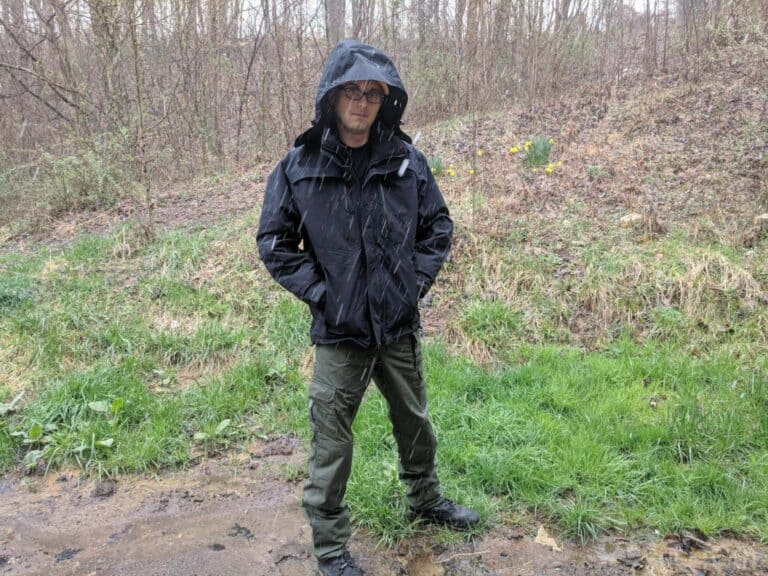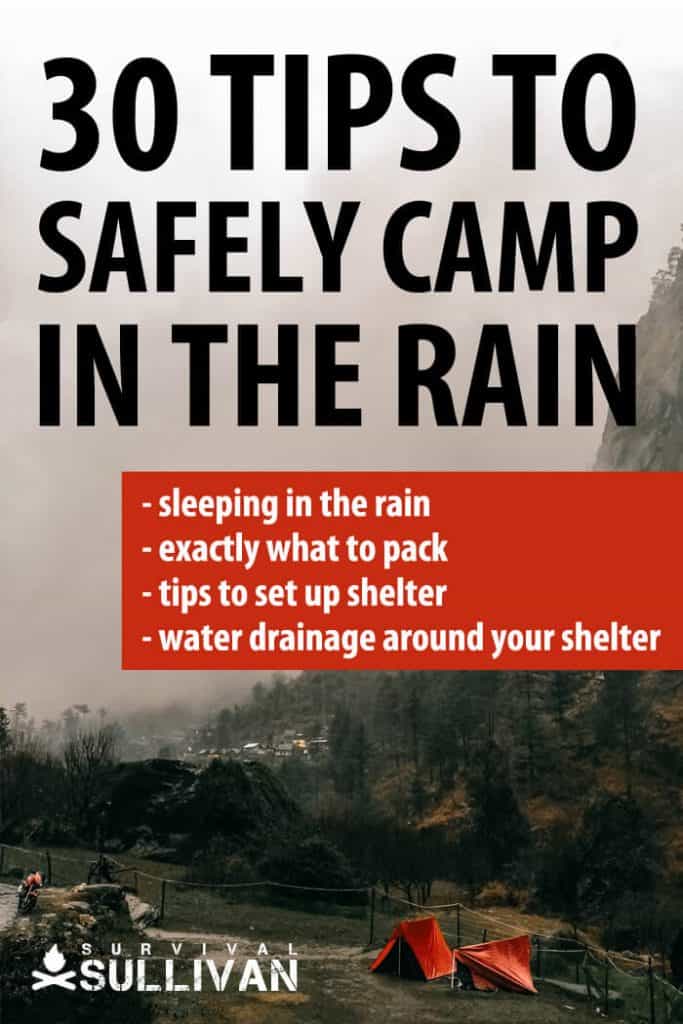Whether you are camping for a weekend or a week or surviving in the bush, you will run into rainy days and nights. There is no avoiding the rain. You can’t put an order in with Mother Nature for sunny days. So how do you handle rainy weather when camping?
The key when camping is to stay as dry as possible and to be prepared so that you can dry out quickly if you do get wet. You can minimize your chances of getting wet if you properly plan out your campsite and come prepared with the right equipment.

There are a number of things to consider when camping in the rain and I’ll break these down here.
Choosing a Campsite
The key (of course) is to stay as dry as possible. You can have the best tent or improvised shelter in the world, and it won’t matter if your campsite it terrible. When choosing a campsite, follow these guidelines:
1. Choose high ground. If you set up low down or in a depression in the ground, then you are going to end up in a large puddle when it rains.
2. Look for a site that has good drainage so that the water will run away from your tent and the “living” areas of your campsite.
3. Select a site that is not too close to a creek, river, or other water source. This way if it rains enough to flood, you won’t get wet.
Choosing a Shelter
4. Make sure your tent is of good quality. Spend the extra money on a tent that has a decent fly cover and one that has a base designed to keep water out.
5. In addition to buying a high-quality tent, it can help tremendously to spray your tent with waterproofing spray prior to the start of the camping season. Even with a waterproofed tent, you will still want a tarp over it and under it (see below).
6. If you are making an improvised shelter, you need to take rain and wind into consideration when choosing the type of shelter to build.
A tent is fully enclosed, which will keep the rain and wind out, but what about a shelter that you make yourself Read more information on how to build shelters here.
7. To protect you from the rain, your shelter will ideally be as enclosed as possible. If you can ensure that it has all sides enclosed, except for the door, such as a teepee-style shelter or a mostly enclosed one-person shelter, this is best.
Position the shelter so that the door is away from the prevailing winds (if possible) so that the rain will not blow inside the shelter.
8. If you are making a shelter using a tarp or a lean-to style and you only have one wall, then put that wall between you and the prevailing winds, again to keep the rain out.
Whatever shelter you build, particularly if you don’t have a tarp to use, be sure to cover the outside of it with brush and leaves to help insulate it and keep the inside dry. Use a tarp above the shelter if possible.
Sleeping in the Rain
This is all about setting up your shelter in the best possible location and ensuring it and you will stay as dry as possible.
9. First, if you are on a slope, set your tent or improvised shelter so that the door/opening is facing downhill. This can be tricky when it is windy.
A tent should be fine in this situation because it has a door, but you will have to use your judgement when it comes to an improvised shelter. Just don’t point the opening of your shelter directly uphill.
10. If you are in a tent, keep all your belongings away from the sides of the tent, and refrain from touching the sides of the tent once the rain begins. Touching the sides or roof of the tent from the inside when it’s wet can cause the rain to leak through rather than running off.
11. Second, tarps are your best friend when it comes to camping. Just take a look at permanent camps and homeless camps and you will see that there are tarps set up over the tents.
12. There are generally tarps under the tents, too. If you are putting a tarp under your shelter, be sure to fold it so that the edges aren’t sticking out. If they are, then water can collect on the edges and run under your tent or shelter.
13. It’s a good idea to dig a trench around your tent or shelter to ensure that any water that does come near it can be directed away from it. Follow these guidelines when digging your trench:
- Start the edge of your trench just past the edge of your tent/shelter
- You want the side of the trench closest to your tent/shelter to go straight down and the side of the trench farthest away from the tent to be sloped. Do NOT make the trench a V-shape because you will be more likely to have water reach your tent.
- The trench should be between 3 and 5 inches deep.
- Dig the trench all the way around the tent/shelter.
- You will want the trench to slope toward the lowest point in the area around the tent/shelter.
- At the lowest point, create an opening so the water can flow out, rather than backing up into the trench.
- If water can come from uphill, then dig a ditch that will direct water away from the tent/shelter.
- When digging, be sure to throw all the dirt away from the tent. If the dirt rests against the tent material, it can cause it to rot.
14. When it comes to your sleeping area inside the tent, have some sort of padding underneath you. This will help keep you dry and insulate you against the cold coming up from the ground, keeping you warmer at night.
15. If you don’t have a pad or blanket you can place underneath you, then you can collect dry brush, grass, or boughs to use as padding.
Daytime in the Rain
When it comes to your daytime activities in the rain, the last thing you want to do is spend your entire day (or many days) sitting inside your dry tent eating (remember, no food in the tent or you will attract the wildlife). To solve this problem, you will once again need tarps.
16. The best plan is to have a large tarp that you can suspend over your dining area, right over the table if you have one.
17. You can also suspend a tarp over the fire pit, giving you a nice spot to sit and relax and enjoy the warmth of the fire on a rainy day. That will definitely help make the weather more bearable.
18. Make sure that when you set up the tarps you give them a peak, like you see on a roof. That way, the water will run off the tarp. If you don’t do this, the water will collect in the middle and the tarp will sag right onto your table or into your seating area.
Ideally, you should peak the tarp in the middle so that there are four sides, rather than an A-frame. This way, you will have more protection from the wind.
19. If you’re traveling through the woods during hunting season, make sure that you wear the appropriate outer wear, typically orange, so that hunters don’t mistake you for a deer or other game.
When it’s raining in the woods, it’s easy to get confused about what exactly you are seeing. You don’t want to end up injured.
What to Pack/Prepare
20. At this point, I’m sure you can figure out what the first item on this packing list is – tarps! And lots of them! In fact, if you can plan ahead, you will need a minimum of three large tarps, one for over the tent, one for under the tent, and one for over your dining table/cooking area.
Aside from tarps and the cordage to hand them, try to pack the following, whether for a regular camping trip or for survival:
21. Pack plastic bags: These should include many garbage bags and large Ziploc bags. These allow your equipment and food to be store away so they stay dry. f your budget allows for it, you can also use dry bags.
22. Pack enough rain gear: Regardless of how sheltered you have made your campsite, water will often still get in. Even if it doesn’t, you will still need to leave the comfort of your sheltered area.
Disclosure: This post has links to 3rd party websites, so I may get a commission if you buy through those links. Survival Sullivan is a participant in the Amazon Services LLC Associates Program. As an Amazon Associate, I earn from qualifying purchases. See my full disclosure for more.
Having a good rain jacket or poncho and good rain pants is a must. Don’t skimp on the price because you will get what you paid for. I promise!
23. Pack proper clothing: You need to keep warm during rainy weather. Even if you have a good shelter and good rain gear, the air will still be damp. Avoid cotton clothing and opt for nylon and synthetic underwear. Cotton will suck up the moisture and it won’t dry quickly, leaving you cold and damp. If the weather is especially cold, then use wool or polypropylene layers.
24. Get a bivvy bag: If you have or plan to purchase a bivvy bag, which is particularly good in survival situations or when you are camping in the bush with minimal gear, you can find one that will keep out the rain.
But you must get a good quality bivvy bag! However, it’s still best to use tarps over and under, and over your dining area.
25. Get a good stove. You will need a stove that is easy to light in the rain, one that runs on gas or propane. For longer term camping trips, a wood stove will also work.
If you have a stove or a protected fire you can also use it to dry out clothing if you do get wet.
26. Lighting Options. Depending on the location and the time of day, rainy weather can typically mean darker skies. Inside the tent will likely be dark even if it’s still daylight outside. Make sure to pack some options for lighting. Consider lanterns for inside the tent and headlamps for those late-night trips to collect firewood or dig a cathole.
27. Batteries. Make sure you pack plenty of extra batteries to keep those lights going and to power your radio. Even those who use solar or crank powered lights will want to have a few battery backups for overcast days or for those times when it’s easy to press a button for light than have to crank for several minutes.
28. Activities: Be sure to pack something to do to keep busy. Sure, this doesn’t have anything to do with keeping dry, but it does have to do with keeping everyone sane, especially when the rain is falling for days. Even a deck of cards is ideal. A board game or two will also help the time fly.
29. Comfort Food: One of the things that can make camping in the rain so unpleasant is being damp and cold. If you want to make camping the rain a bit more bearable, be sure to pack comfort food such as hot cocoa, soup, oatmeal, or stuff to make chili. Something hot at mealtimes can really help chase away that damp, cold feeling.
Don’t Avoid the Rain…
…Embrace it! Seriously, if you want to get a good amount of camping in over the season, then you can’t avoid the rain.If you are given no choice but to be in the outdoors (due to a survival situation), then it is guaranteed you will be in the rain at times.
30. Hang wet clothes and bedding. Camping in the rain means you are bound to end up with wet clothes, socks, and even bedding. But if you take off your wet clothes and can change into dry ones, you’ll have a much more pleasant time.
Take an extra clothesline to hang clothes or wet bedding either in your tent or under your campfire tarp so they can dry. In a pinch, you can even put damp socks or underclothes into the bottom of your sleeping bag overnight and let your body heat dry them out so you can wear them in the morning.
As long as you are prepared, you won’t end up in an emergency situation, with a wet shelter, no way to cook, and no way to keep dry. Will you get wet? Sure, at some point you are bound to get a little wet, but if you are prepared, you can have fun, keep your sanity, and stay mostly dry even if it is raining.

updated 11/27/2019 by Megan Stewart

An urban prepper and rural wannabe, Karen has been working as a freelance writer for a decade and prepping for about half that time. She has gathered a wealth of knowledge on preparing for SHTF, but there is always more to learn and she has a passion for gathering and sharing that knowledge with other like-minded folk. Karen lives in London, Canada with her two children and plethora of cats.

Rain remains a survival reality for anyone who lives extended time in the wilderness. This is true world-wide in
all temperate or alpine climes. In SE Alaska or the Olympics of Washington, you can only count on dry material
for fire, etc., from dead tree snags. A woodsman cruise axe and light weight bow saw are always welcome tools
in a rain environment. I spent four years in AK and whole summers in the rainy North Cascade wilderness. You
do good in your article here.
What most people seem to ignore is that they coudl easily catch cold if unprepared. Then their entire bug out is compromised.
WHEN I WAS A KID
I WAS A BOY SCOUT PLUS I LIVE IN LOUISIANA HAHA LOL
AND THERE IS A WHOLE LOT OF RAIN HERE ON THE GULF COAST
WE LEARN VERY QUICKLY HOW TO DEAL WITH THE RAIN
AND IF YOU PREPARED YOUR WILL HAVE A VERY PEACEFUL DAY AND NIGHT
LISTENING TO THE RAIN FAILING ON THE TREES AND YOUR SHELTER
IS VERY RELAXING
AND MAN CAN YOU SLEEP GOOD
AGAIN IT’S ALL ABOUT BEING PREPARED
THAT’S THE BOY SCOUT MOTTO
AND THAT GO’S FOR EVERYTHING IN LIFE
BUT TODAY YOUNG PEOPLE ALL THEY WANT IS THERE SMART PHONE OR THERE PC
AND THERE’S NOTHING WRONG WITH HAVING A SMART PHONE OR A PC
BUT JUST DON’T DEPEND ON YOUR
PHONE OR PC
USED YOUR GOD GIVEN SENSE AND SURVIVING WON’T BE THAT DIFFICULT
AGAIN IF YOU USE COMMON SENSE
AND PREPARE FOR ANYTHING THAT LIFE THROWS AT YOU
AND FIRST AND FOREMOST ALWAYS TRUST IN GOD THE FATHER AND HIS SON JESUS CHRIST OUR LORD AND SAVIOR
BECAUSE GOD WILL ALWAYS GUIDE YOU THROUGH RUFF TIMES
IF YOU PRAY AND ASK GOD TO HELP YOU
BECAUSE GOD GIVES US ALL A FREE WILL
IT’S ALWAYS UP TO US TO MAKE THE RIGHT CHOICES
THE LORD GIVES US GOOD COMMON SENSE
IT’S UP TO US TO USE
WHAT GOD HAS GIVEN US
BEFORE THERE WAS ALL OF THIS NEW TECHNOLOGY
MAN KIND ALWAYS SURVIVE
MOST PEOPLE TODAY ARE LAZY AND WANT SOMEONE ELSE TO DO ARE GIVE THEM EVERYTHING
BECAUSE EVERYTHING THAT HAPPENED TO THEM
IS SOMEONE ELSE FAULT
THIS IS WHY SAD TO SAY
WHEN THE SHTF MOST OF THE PEOPLE TODAY WILL TURN INTO WILD ANIMALS
BEFORE THEY KILL EACH OTHER OR DIE OF THIRST AND STARVATION
BECAUSE THEY THINK THAT THE GOVERNMENT WILL TAKE CARE OF THEM
AND WOW WILL THESE PEOPLE BE IN FOR A RUDE AWAKENING
PEOPLE REALLY NEED TO LEARN HOW TO TAKE CARE OF THEM SELF AND FAMILY
AND OTHER IF THEY CAN
I THANK SURVIVAL SULLIVAN FOR ALL OF THE EXTRA INFORMATION THAT YOU PROVIDED ME WITH
BECAUSE OF ALL THE INFORMATION THAT YOU PROVIDE
THERE WILL BE HUNDREDS OF THOUSANDS OF PEOPLE IF NOT MORE
THAT WILL SURVIVE WHEN THE SHTF
AND I KNOW THAT GOD HAS ALREADY BLESSED YOU
AND GOD WILL CONTINUE TO BLESS YOU
AGAIN THANK YOU SO VERY MUCH
DENVER
Amen, Mr. Denver. Well said, Sir. God bless you.
Excellent information. We could’ve used it when we were young and my pappy was inexperienced. I can remember our backpacked friend falling into a very cold brook as he overconfidently swaggered across an ice bridge. We all got a good laugh, never having heard about hypothermia. But we had fun, thanks be to God. Speaking of God,. Can you say Rapture? You won’t find the term in the Bible but you can read about it in John 14:1-4 and 1 Thessalonians 4:13-18. Thank you sir and ma’ms.
Ready here for the Rapture (and for whatever happens during the wait time between now and then)! Thank you for putting the reminder out there for folks. It’s up to them then to study and accept/get ready. Sadly, too many reject and refuse to educate themselves. Not this girl and her family! Prayers by for all that more realize the truth before its too late. God bless you, I’m never and all, especially Survival Sullivan for the wealth of preparedness information.
Sorry for the typos, but I think y’all can figure it out!